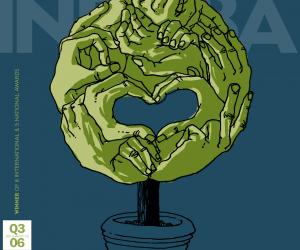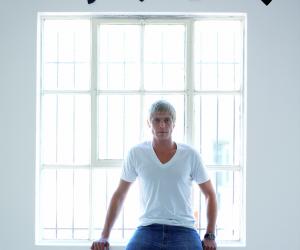First Published in
Until I started to research recycling, I wasn't really aware of how beneficial it actually is as an energy- and space-saving activity. Reading through figures and 'factoids' about the positive effects and resource-saving results of a few simple behavioral changes was en-lightening, to say the least; it corroborated my longstanding (yet previously uninvestigated) belief that "recycling is good". Recycling is more than good, it is absolutely essential for the future of our planet, and is a new way of life, rather than some abstract ideal.
I started to design and make things out of old, used plastic containers kind of by accident… as much as anything is accidental. I met my current production manager, Richard Mandongwe, who is also a very skilled craftsman, at an outdoor market. He was selling some of the most exquisite and inspiring objects I had ever seen: flowers made from old plastic bottles and wire in which I saw a potential that I've been exploring, with Richard as my right-hand man, for the past few years.
At that time (mid 2003), the search was on, for me, personally, to find and/or to create new objects that spoke of my country, South Africa, in a very direct and unequivocal way. I'd come from a Fine Art background, and my design language was strongly based in geometry and crisp, clean lines, facets, folds and cutouts. This was largely due to my choice of materials up until then. I'd really only used paper and other flat substrates as the starting point for all my work.
In making things, I have always used the connection between choice of material (what an object is made of) and the finished object (the way an object looks) as a primary influence. My personal (somewhat Modernist) fascination with 'painting for painting's sake' or the notion of using sculpture as a means of exploring space, immediately came into play when I saw Richard's flowers. The plastic that formed the flowers was not pretending to be anything but scrap plastic, in fact nothing else could behave as this material did. In this lay its immediate appeal. A new and exciting medium had found me. To see these beautiful objects at that specific time opened up a vista of possibilities in terms of a new and unique personal aesthetic - which was just what I had been looking for.
After having started to play with this medium, which is a viable and extremely beautiful one, I have found new ways to deal with the material itself. I encountered unexpected hurdles along the way. I've found different qualities in different types of plastics - there's opacity versus translucency; subtle gradations and differences in colour and thickness; and overlays, like a transparent brown on white for instance - whilst simultaneously battling to find enough raw material to continue with proper production. Some of the coloured HDPE (high density polyethylene) bottles are especially difficult to source, such as purple, light blue and brown, with translucent green being very scarce.
This has restricted my production capacity quite severely. I've been forced to find partners in the simple act of procuring my medium of choice. Very recently I partnered with an environmental organization called Footprints and with the Oasis Association, which runs great recycling centres around Cape Town and now supplies most of my current material needs. I find this unfortunate fact so crazy. I need more rubbish than I can get. And the majority of people around me are just tossing it in the bin - depositing it straight into our landfills, which grow daily, and unnecessarily.
My dream is something like this: To have a centralized 'materials bank' from which to draw as much raw material as I need without having to constantly source and clean mountains of rubbish for myself. In achieving this dream, I am being aided by Footprints in that the organization has dedicated itself to the task of taking responsibility for our environmental footprint on this incredibly beautiful part of the planet. The local situation is improving very slowly, but it's not happening easily, because too few people are making all of the effort. For me, as a designer, it's taking a lot of time and energy that I should be putting elsewhere - simply because I'm good at other things, like design. In order for any real progress to be made in sustaining our environment, we all need to take individual responsibility and we can at the very least start by each simply taking charge of our personal waste.
I've never really perceived of myself as a leader before, but I've lately come to realise that what I've helped to do, by publicizing the use of plastic waste as a craft material, has been a fairly pioneering move. I've played a role in broadening some people's perceptions of waste. Hopefully this notion will grow, leading to every household in the country separating and cleaning their rubbish, making compost from their organic waste, and re-using those glass jars, shoe-boxes and old computer parts…
Just remember the three R's
REDUCE the amount of waste you produce.
REUSE as much of that excess packaging as you can.
RECYCLE by learning how to separate your waste, where to drop it off near your home/workplace - being careful of carbon emissions at the same time - and following through by actually doing it.











